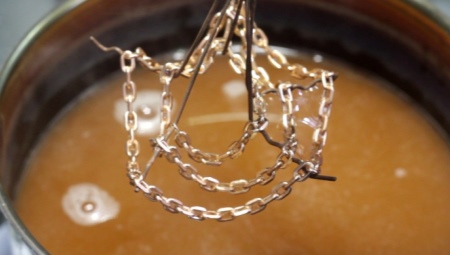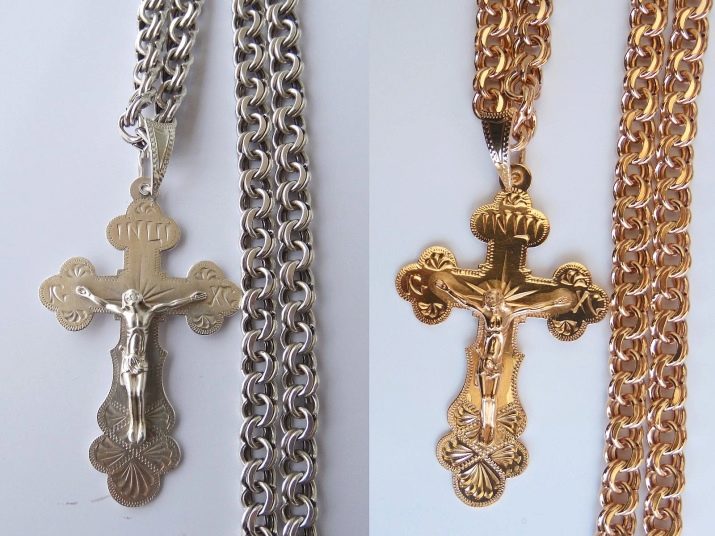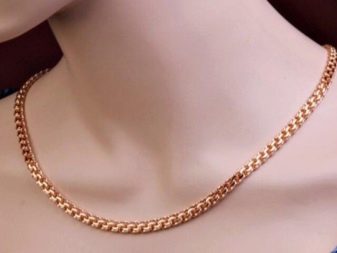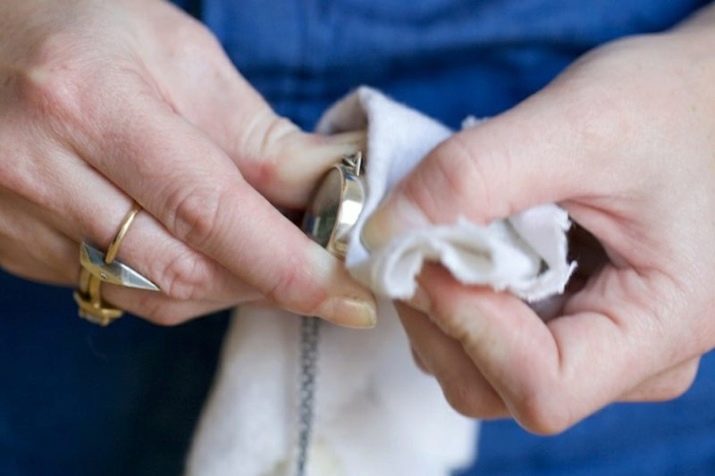Silver gilding: features and methods

Silver items with gilding have a pleasant value with a noble appearance. This is what usually attracts buyers. Products, of course, have not only positive qualities, but also negative ones. There are two methods of applying gilding, which differ in complexity. The durability of the coating directly depends on the care of the jewelry.

Advantages and disadvantages
Plating silver jewelry with gold allows you to enjoy a product of a noble look at a more affordable price. Such jewelry has its advantages.
- The general availability of products comes first. The cost of jewelry with gilding is much lower than that of gold. If the gilding of silver is done correctly, then it is almost impossible to find visual differences.
- There is an opportunity to experiment without special financial costs. You can order a complex piece of jewelry with engraving or unusual patterns from a jeweler at a nice price. At the same time, gilding will make the appearance more attractive.
- Silver cutlery is much lighter than gold. However, processing allows the use of quality products with an expensive look. Weight matters for jewelry too. So, a necklace made of gilded silver with stones will last longer than a gold one due to its lightness.
- The coating can be repaired as needed. If the gilding has deteriorated somewhere or just began to look less attractive, then any jeweler will help to restore its former gloss. Restoration costs a lot, but it will definitely be cheaper than buying a new piece of jewelry.
- It is possible to change the color of the coating. You can change the yellow gilding to white and vice versa. Also, the master can compact the layer.
- Subject to all operating rules gold plated silver lasts a long timewithout losing its original appearance.
- Gilding is simply irreplaceable for watch movement parts and large equipment. So silver conducts heat better and becomes denser.



Gold plated silverware is quite attractive and interesting. Before buying, it is worth considering the cons.
- When using, you need to constantly be on the lookout. The products should not come into contact with water and skin again. Jewelry should be removed before going to bed, swimming or playing sports. Substances found in the environment destroy the gilding layer.
- Gold of high standard is used for decoration. It shines a lot. This is what gilded silver gives out. Less shiny alloys are used to make gold jewelry.
- The decorative layer does not prevent metal oxidation. Traces of green or black may still remain from the product.
- Tableware with gilding requires a rather difficult care. It cannot be washed in a dishwasher or using chemicals. For cleansing, exclusively specialized solutions are used.
- There is a great risk of acquiring a fake. It is quite difficult to determine the quality of gilding by eye. However, it is the sample of gold over silver that affects the price of the item. You can contact an independent jeweler for help immediately after purchase.

What is it suitable for?
Almost any piece of silver can be gilded. Of course, jewelry comes first. You can cover chains, rings, earrings, pendants, brooches and similar things. The gilding of the silver setting of the icon is popular. You can cover crosses, watches of any kind, blades, knives and swords. In other words, gilding is suitable for all silver items, regardless of their size.



Methods
You can gild a product at home using a chemical or galvanic method. Each of them has its own characteristics.
Galvanic
The plating is applied in 925 gold. Gilding makes the product more valuable. The main coating methods are sodium, ether and zinc contact. One is the most effective galvanic method.
This method is best suited for processing jewelry.
To create a gold coating, silver is dipped in an aqueous solution of salts. Then an electric shock is applied. In this case, gold acts as an anode and silver as a cathode.

Let's take a look at an example of the process of electroplating.
- Pour electrolyte into a small container.
- Dissolve gold in liquid.
- Place the silver jewelry in a container and leave for a while. In the process, an electric current must pass through the liquid.
- Oxides will begin to settle on the product. The layer is very thin.
- Take out the decoration and leave to dry completely.
- Polish or cover with a special protective layer.

The layer turns out to be really very thin, but it is distinguished by its strength and durability. It is worth noting that the gold plating can be made thicker, there are no restrictions. Usually the jeweler negotiates this point with the client.

Certain alloys are used for gilding by this method.
- Solid yellow gold. There are no additives in the alloy, 999 standard metal is used.
- Yellow gold with a small amount of cobalt. The sample is still the same, 999. The additive is needed solely for strength, it does not affect the appearance.
- Red gold, also called Russian. You can also make pink, Italian. The latter has a little more yellowness. Shades range from coppery red to pale pink.
- Green gold. An alloy with added silver or nickel is used.
- White gold. The rhodium plating process is used.

The total cost of the product depends exactly on what alloy is used for the gilding.
It should be noted that the first two options are the most expensive, but there are some nuances.An overabundance of luster strongly distinguishes the finished product made of silver from the same one made of gold.
Italian or Russian alloy will be the golden mean.

Chemical
The process involves the application of gold chloride to a silver piece. Initially, the gold is rolled into foil and then crushed. Then the particles are dipped into a composition of hydrochloric and nitric acid. It is also called royal vodka.

You can gild at home by following the step-by-step instructions.
- Prepare a solution of 30 g of hydrochloric acid and 10 g of high concentration nitric acid. 1 g of gold will require 10 ml of liquid.
- Dissolution must be carried out in a porcelain container. The process takes from a couple of hours to 2-3 days.
- After complete dissolution, evaporate the composition in a water bath at a temperature of 70-80 ° C. The result is a viscous liquid. The gold should be stirred during evaporation with a glass rod.
- Degrease a silver object with 10-20% sodium or boil in a soda solution. Wash in 25% hydrochloric acid solution. Then you should rinse the jewelry with water.
- Immerse the product in the composition. After a while, the item will be gilded.
- Remove from the container, rinse the decoration. Wipe dry and buff with a wool cloth.



Additionally, it should be noted that there are different ways to prepare a mixture for gilding using a chemical method. And gold can be used in different samples. The process is longer than when using electroplated gold plating. When working with acids, you should adhere to all safety rules. It is important to carry out gilding in a ventilated area and using protective equipment.

How long does gilding last?
After the procedure, the silver product is covered with a thin film. She is decorative and quite sensitive to the external environment. Adverse factors include the following:
- contact with water and chlorine in it;
- harsh chemicals;
- improper care of the subject;
- excessive rubbing against human skin, contact with sweat.


With daily use, it is worth paying a lot of attention to caring for the product. Excessive moisture will oxidize silver.
It is fair to say that corrosion appears on additional alloy metals, copper and nickel. These components begin to darken, become covered with bloom, and not the silver itself.
Remove the gold-plated ring before cleaning or washing. Interaction with aggressive and any other household chemicals accelerates the oxidation process. You should also remove any gilded items before washing and showering. Increased friction will thin the gold layer until it is completely abraded. It is best to remove jewelry before exercising.


Some people claim that gilding is quickly erased from silver, and there is no sense in it at all. However, there are simple rules of use that will allow you to enjoy the decorative layer for years.
- Earrings, bracelets and chains should be removed before bathing. Avoid contact with soapy water.
- It is important to store gilded silver in a closed container, away from sunlight and high humidity. It makes sense to make layers between jewelry using soft cloths or use different boxes. So the products will not scratch each other.
- Products need to be cleaned, but only in the correct way.
- Do not store jewelry in the bathroom or kitchen. High humidity will result in a loss of attractive gloss.


Gilded silver requires adequate maintenance. If an ordinary ring can be cleaned with a soft toothbrush, then in this case the film will be completely damaged.
The main helpers when cleaning gilded jewelry:
- suede cloth;
- ethanol;
- vinegar.
The suede is for polishing. It can be used immediately after cleaning. Also, a suede cloth is useful if the jewelry is worn every day. It should be polished in the evenings before storing it in the box.

Do not immerse the gilded product in soda or soapy water. This will damage the decorative layer. It is allowed to apply alcohol on a cotton pad and wipe the decoration. If the contamination is significant, you can immerse the garment in the vinegar solution for 20 minutes or less.

Will add shine and alcohol to the gilding. You can also place the product in beer for 15 minutes for the same purpose. Regular cleansing of gilded silver can be done with a light vinegar solution and a lint-free cloth. It is enough to moisten a cloth and gently wipe the jewelry. Strongly active cleaning is not worth it, as well as pressing.

The following video demonstrates an express method for gilding silver.








